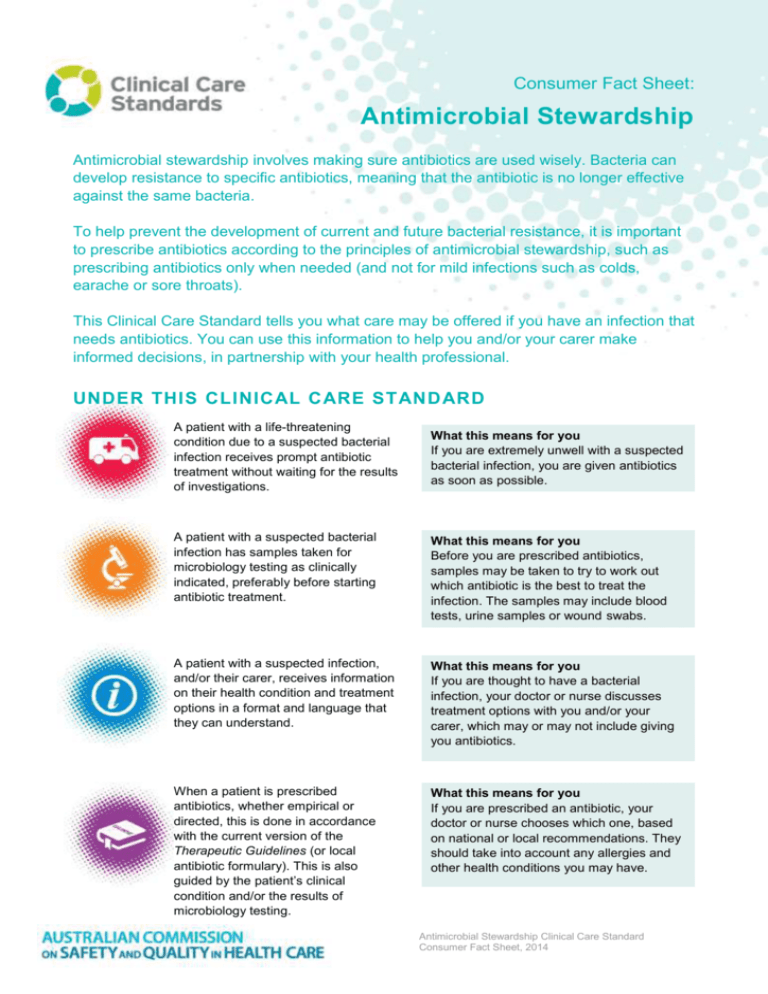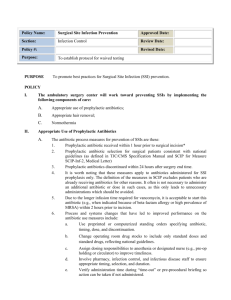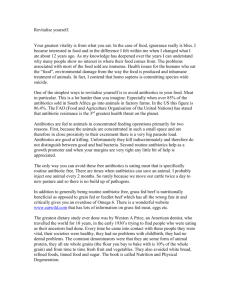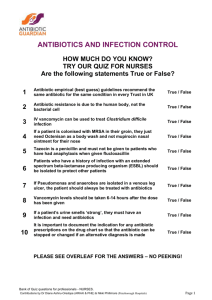AMS-Clinical-Care-Standard-Consumer-Fact
advertisement

Consumer Fact Sheet: Antimicrobial Stewardship Antimicrobial stewardship involves making sure antibiotics are used wisely. Bacteria can develop resistance to specific antibiotics, meaning that the antibiotic is no longer effective against the same bacteria. To help prevent the development of current and future bacterial resistance, it is important to prescribe antibiotics according to the principles of antimicrobial stewardship, such as prescribing antibiotics only when needed (and not for mild infections such as colds, earache or sore throats). This Clinical Care Standard tells you what care may be offered if you have an infection that needs antibiotics. You can use this information to help you and/or your carer make informed decisions, in partnership with your health professional. UNDER THIS CLINICAL CARE STANDARD A patient with a life-threatening condition due to a suspected bacterial infection receives prompt antibiotic treatment without waiting for the results of investigations. What this means for you If you are extremely unwell with a suspected bacterial infection, you are given antibiotics as soon as possible. A patient with a suspected bacterial infection has samples taken for microbiology testing as clinically indicated, preferably before starting antibiotic treatment. What this means for you Before you are prescribed antibiotics, samples may be taken to try to work out which antibiotic is the best to treat the infection. The samples may include blood tests, urine samples or wound swabs. A patient with a suspected infection, and/or their carer, receives information on their health condition and treatment options in a format and language that they can understand. What this means for you If you are thought to have a bacterial infection, your doctor or nurse discusses treatment options with you and/or your carer, which may or may not include giving you antibiotics. When a patient is prescribed antibiotics, whether empirical or directed, this is done in accordance with the current version of the Therapeutic Guidelines (or local antibiotic formulary). This is also guided by the patient’s clinical condition and/or the results of microbiology testing. What this means for you If you are prescribed an antibiotic, your doctor or nurse chooses which one, based on national or local recommendations. They should take into account any allergies and other health conditions you may have. Antimicrobial Stewardship Clinical Care Standard Consumer Fact Sheet, 2014 When a patient is prescribed antibiotics, information about when, how and for how long to take them, as well as potential side effects and a review plan, is discussed with the patient and/or their carer. When a patient is prescribed antibiotics, the reason, drug name, dose, route of administration, intended duration and review plan is documented in the patient’s health record. A patient who is treated with broad-spectrum antibiotics has the treatment reviewed and, if indicated, switched to treatment with a narrow-spectrum antibioitc. This is guided by the patient’s clinical condition and the results of microbiology tests. What this means for you If you are prescribed antibiotics, your doctor or nurse discusses with you and/or your carer about when and how to take your antibiotics, how long to take them and any potential side effects. You may need to be seen again to review your progress. What this means for you Your health record contains the details of your antibiotic treatment. This includes information on why you were prescribed antibiotics, the medicine name, the dose, how you take them (i.e. as tablets or an injection), how long to take them and any plans to review your treatment. What this means for you If it is unclear which bacteria may be causing your infection, you may be prescribed an antibiotic that works against a wide range of bacteria (i.e. a broadspectrum antibiotic). In this case, your doctor or nurse may order tests to review your progress and, on seeing the results, your treatment may change to a more specific antibiotic (i.e. a narrow-spectrum antibiotic). If investigations are conducted for a suspected bacterial infection, the responsible clinician reviews these results in a timely manner (within 24 hours of results being available) and antibiotic therapy is adjusted taking into account the patient’s clinical condition and investigation results. What this means for you If tests have been done to identify a suspected bacterial infection, your doctor or nurse reviews these results as soon as they are available (usually within 24 hours of being available). These results may lead to your antibiotic treatment changing or stopping. If a patient having surgery requires prophylactic antibotics, the prescription is made in accordance with the current Therapeutic Guidelines (or local antibiotic formulary), and takes into consideration the patient’s clinical condition. What this means for you Antibiotics may be given to you before surgery to reduce the risk of an infection after surgery. The prescription is also based on national or local recommendations. More information on the Clinical Care Standards program is available from the Australian Commission on Safety and Quality in Health Care website at www.safetyandquality.gov.au/ccs. Antimicrobial Stewardship Clinical Care Standard Consumer Fact Sheet, 2014








